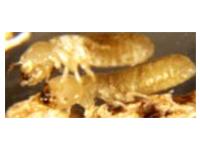Confused Flour Beetle (Also see Rust-Red Flour Beetle)
Granary Weevil (Also see Rice Weevil)
Mediterranean Flour Moth or Mill Moth
Red-legged Ham or Copra Beetle
Rice Weevil (Also see Granary Weevil)
Rust-Red Flour Beetle (Also see Confused Flour Beetle)
Tropical Warehouse or Almond Moth (Also see Warehouse, Tobacco or Cocoa Moth)
Warehouse, Tobacco or Cocoa Moth (Also see Tropical Warehouse or Almond Moth)

Notes
These social insects infest dry wood and do not require contact with the soil.
Habits
Drywood termites form colonies of up to 2,500 members. Unlike subterranean termite species, drywood termite colonies do not have a worker caste. The work is done by immature termites before they reach adulthood.
Habitat
Drywood termites infest dry wood, like that found in attic framings.
Threats
Drywood termites can infest structures and cause significant damage.

